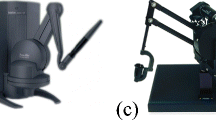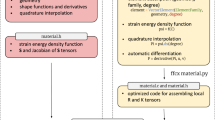Abstract
We present a mechanics-based interactive multi-modal environment designed as part of a serious gaming platform. The specific objectives are to teach basic suturing and knotting techniques for simple skin or soft tissue wound closure. The pre-wound suturing target, skin, or deformable tissue is modeled as a modified mass-spring system. The suturing material is designed as a mechanics-based deformable linear object. Tools involved in a typical suturing procedures are also simulated. Collision management modules between the soft tissue and the needle, the soft tissue and the suture are analyzed. In addition to modeling the interactive environment of a typical suturing procedure, basics of the modeling approaches on the evaluation of a stitch formed by the user are also discussed. For example, if needle insertion points are too close from each other or to the edge of the wound, when the suture is pulled, the suture will tear the soft tissue instead of suturing the incision together. Experiment results show that our simulator can run on a standard personal computer and allow users to perform different suturing patterns with smooth graphics and haptic feedback.



























Similar content being viewed by others
Explore related subjects
Discover the latest articles, news and stories from top researchers in related subjects.References
Baraff D (1997) Implicit method for differential equations. In: Physically based modelling: principles and practice, ACM SIGGRAPH course notes
Berkley J, Weghorst S, Gladstone H, Raugi G, Berg D, Ganter M (1999) Banded matrix approach to finite element modeling for soft tissue simulation. Virt Real Res Dev Appl 4:203–212
Berkley J, Turkiyyah G, Berg D, Ganter M, Weghorst S (2004) Real-time finite element modeling for surgery simulation: an application to virtual suturing. IEEE Trans Visual Comput Graph 10(3):314–325
Bridson R, Fedkiw R, Anderson J (2002) Robust treatment of collisions, contact and friction for cloth animation. In: Proceedings of the 29th annual conference on computer graphics and interactive techniques. pp 594–603
Bro-Nielsen M (1998) Finite element modeling in surgery simulation. Proc IEEE 86:490–503
Bro-Nielsen M, Cotin S (1996) Real-time volumetric deformable models for surgery simulation using finite element and condensation. EUROGRAPHICS’96 15(3):C57–C66
Brown J, Montgomery K, Latombe J-C, Stephanides M (2001) A microsurgery simulation system. In: Proceedings of medical image computing and computer aided interventions, The Netherlands
Brown J, Latombe J, Montgomery K (2004) Real-time knot tying simulation. The Visual Comput Int J Comput Graph 20(2):165–179
Cao DQ, Dongsheng Liu, Charles WH-T (2006) Three dimensional nonlinear dynamics of slender structures: Cosserat Rod element approach. Int J solids Struct 43(3–4):760–783
Cha JJ, Payandeh S (2007) Interactive cross cutting. In: Proceedings of IEEE international conference on robotics and automation (ICRA ’07), pp 2576–2581
Chen DT, Zeltzer D (1992) Pump it up: computer animation of a biomechanically based model of muscle using the finite element method. Comput Graph 26(2):89–98
Colgate JE, Stanley MC, Brown JM (1995) Issues in the haptic display of tool use. In: Proceedings of IEEE intelligent robots and systems, pp 140–145
Grégoire M, Schömer E (2006) Interactive simulation of one-dimensional flexible parts. In: Proceedings of the 2006 ACM symposium on solid and physical modeling, pp 95–103
Hui Z, Payandeh S, Dill J (2004) On cutting and dissection of virtual deformable objects. In: Proceedings 2004 IEEE international conference on robotics and automation (ICRA ’04), pp 3908–3913
Hutchinson D, Preston M, Hewitt T (1996) Adaptive refinement for mass/spring simulation. In: Proceedings of 7th eurographics workshop on animation and simulation, pp 31–45
Kahl B, Henrich D (2005) Manipulation of deformable linear objects: force-based simulation approach for haptic feedback. In: Proceedings of 12th international conference on advanced robotics (ICAR 2005), pp 115–122
LeDuc M, Payandeh S, Dill J (2003) Toward modeling of a suturing task. In: Proceedings of Graphics Interface (GI), pp 273–279
Lenoir J, Meseure P, Grisoni L, Chaillou C (2002) Surgical thread simulation. In: Proceedings of modelling & simulation for computer-aided medicine and surgery, (MS4CMS), pp 102–107
Lenoir J, Meseure P, Grisoni L, Chaillou C (2004) A suture model for surgical simulation. In: 2nd International symposium on medical simulation (ISMS’04), pp 105–113
Lian LL, Chen YH (2006) Haptic surgical simulation: an application to virtual suture. Computer-Aided Des Appl 3(1–4):203–210
Marshall P, Payandeh S, Dill J (2005) Suturing for surface meshes. In: Proceedings of the IEEE international conference on control applications, pp 25–30
Marshall P, Payandeh S, Dill J (2006) A study on haptic rendering in a simulated surgical training environment. In: Proceedings of the symposium on haptic interfaces for virtual environment and teleoperator systems, pp 241–247
Meyer M, Debunne G, Desbrun M, Barr AH (2000) Interactive animation of cloth-like objects for virtual reality. J Vizual Comput Animat 12(1):1–12
Moody L, Baber C, Arvanitis TN (2001) The role of haptic feedback in the training and assessment of surgeons using a virtual environment. In: Proceedings of EuroHaptics
Pai D (2002) Strands: interactive simulation of thin solids using cosserat models. Comput Graph Forum 21(3):347–352
Payandeh S, Azouz N (2001) Finite elements, Mass-Spring-Damper systems and haptic rendering. In: Proceedings of IEEE international symposium on computational intelligence in robotics and automation, pp 224–230
Phillips J, Ladd A, Kavraki LE (2002) Simulated knot tying. In: Proceedings of IEEE international conference on robotics and automation, pp 841–846
Provot X (1995) Deformation constraints in a mass-spring model to describe rigid cloth behavior. Graphics Interface, pp 147–154
Robert VO, Robert RP, Thomas MK, William CB, Nancy HC, Webb RR, Whitney JB, Marc R (1999) Measuring and developing suturing technique with a virtual reality surgical simulator. J Am Col Surg 189(1):114–127
Saha M, Isto (2006) Motion planning for robotic manipulation of deformable linear objects. In: Proceedings of IEEE international conference on robotics and automation, pp 2478–2484
SensAble Technologies, Inc. (2005) penHaptics Toolkit version 2.0 PROGRAMMER’S GUIDE
SensAble Technologies, Inc. (2005) OpenHaptics Toolkit version 2.0 API REFERENCE”
Shi HF, Payandeh S (2007) Real-time knotting and unknotting. In: Proceedings of IEEE international conference on robotics and automation (ICRA ’07), pp 2570–2575
Takamatsu J, Morita T, Ogawara K, Kimura H, Ikeuchi K (2006) Representation for knot-tying tasks. IEEE Trans Robot 22(1):65–78
Terzopoulos D, Waters K (1990) Physically-based facial modeling, analysis, and animation. J Visual Comput Animation B 1(2):73–80
Vafai N, Payandeh S (2010) Toward the development of interactive dissection with haptic feedback. Virtual Real 14(2):85–103
Wakamatsu H, Takahashi K, Hirai S (2005) Dynamic modeling of linear object deformation based on differential geometry coordinates robotics and automation. In: Proceedings of the IEEE international conference on Publication, pp 1028–1033
Wakamatsu H, Arai E, Hirai S (2006) Knotting/unknotting manipulation of deformable linear objects. Int J Robot Res 25(4):371–395
Wang C, Richardson AMD, Liu D, Rosing R, Tucker R, De Masi B (2003) Construction of nonlinear dynamic MEMS component models using Cosserat Theory. In: Proceedings of SPIE design, test, integration & packaging of MEMS symposium
Wang F, Burdet E, Dhanik A, Poston T, Teo CL (2005) Dynamic thread for real-time knot-tying. In: Proceedings of the first joint eurohaptics conference and symposium on haptic interfaces for virtual environment and teleoperator systems
Webster RW, Zimmerman DI, Mohler BJ, Melkonian MG, Haluck RS (2001) A prototype haptic suturing simulaton. Stud Health Technol Inform 81:567–569
Author information
Authors and Affiliations
Corresponding author
Rights and permissions
About this article
Cite this article
Payandeh, S., Shi, F. Interactive multi-modal suturing. Virtual Reality 14, 241–253 (2010). https://doi.org/10.1007/s10055-010-0174-6
Received:
Accepted:
Published:
Issue Date:
DOI: https://doi.org/10.1007/s10055-010-0174-6




